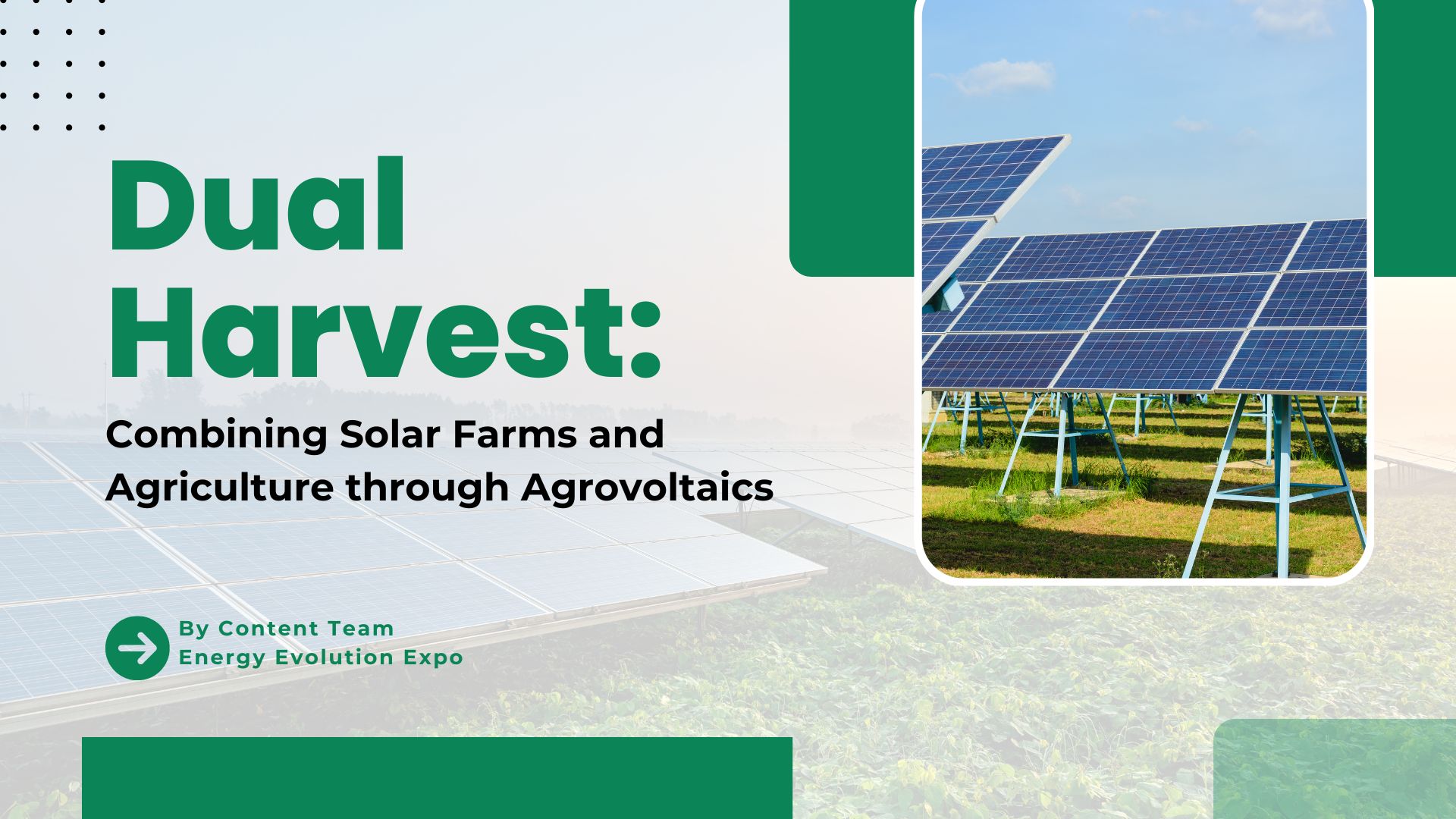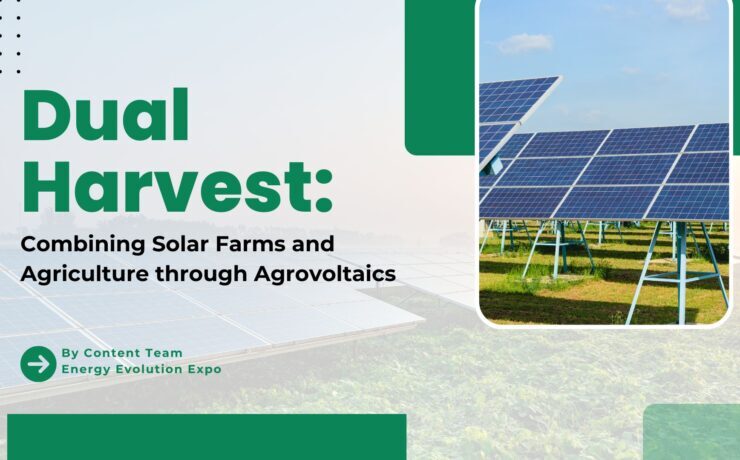Dual Harvest: Combining Solar Farms and Agriculture through Agrovoltaics

Types of Agrovoltaic Systems
Types of Agrovoltaic Systems
1. Fixed Tilt Systems: These systems involve solar panels mounted at a fixed angle, usually optimized for maximum solar energy capture. The panels are elevated above the ground, allowing crops to grow underneath. This type of system is relatively simple to install and maintain but may require careful planning to ensure adequate sunlight reaches the crops.
2. Tracking Systems: These systems use solar panels mounted on structures that can move to follow the sun’s path across the sky. Tracking systems can significantly increase solar energy production compared to fixed systems. However, they are more complex and expensive to install and maintain. They can be designed to adjust the angle to allow for more or less sunlight to reach the crops as needed.
3. Vertical Systems: In vertical agrovoltaics, solar panels are mounted vertically or at a steep angle, creating more space for crops on the ground. This type of system is particularly useful for crops that require partial shading or can benefit from the altered microclimate created by the panels.
4. Floating Systems: These systems involve solar panels installed on bodies of water such as ponds, lakes, or reservoirs used for agricultural irrigation. Floating agrovoltaics can reduce water evaporation and improve water quality while generating renewable energy.
Benefits of Agrovoltaics
Benefits of Agrovoltaics
1. Increased Land Use Efficiency: Agrovoltaics allows for dual land use, combining agricultural production and solar energy generation on the same plot of land. This approach can be particularly beneficial in regions with limited arable land.
2. Enhanced Crop Yield: Some crops can benefit from the partial shading provided by solar panels, which can reduce heat stress and water evaporation. This can lead to increased crop yields and improved crop quality in certain climates.
3. Renewable Energy Production: By integrating solar panels into agricultural land, agrovoltaics contributes to the production of clean, renewable energy, helping to reduce reliance on fossil fuels and decrease greenhouse gas emissions.
4. Economic Diversification: Farmers can generate additional income by leasing their land for solar energy production or by directly selling the electricity generated. This diversification can help stabilize farm income and improve economic resilience.
5. Climate Resilience: Agrovoltaics can enhance the resilience of agricultural systems to climate change by providing shade, reducing water needs, and protecting crops from extreme weather events.
Challenges of Agrovoltaics
Challenges of Agrovoltaics
1. Initial Costs: The installation of agrovoltaic systems can be expensive, requiring significant upfront investment. This can be a barrier for small-scale farmers or those with limited access to capital.
2. Maintenance and Management: Managing the dual use of land for both agriculture and solar energy production can be complex. It requires careful planning and coordination to ensure that both systems operate effectively without interfering with each other.
3. Crop Selection: Not all crops are suitable for growth under solar panels. Crop selection must consider factors such as light requirements, growth patterns, and compatibility with the shading provided by the panels.
4. Regulatory and Policy Barriers: In some regions, regulatory and policy frameworks may not be well-suited to the integration of agrovoltaics. Navigating these barriers can be challenging and may require advocacy and policy changes.
5. Technological Integration: The integration of advanced technologies such as tracking systems and vertical panels can be technically challenging and may require specialized knowledge and expertise.
Here are few examples to show the application of Agrovoltaics in various countries especially Europe:
1. Heggelbach Farm, Germany:
The Heggelbach Farm in Germany has successfully implemented an agrovoltaic system combining organic crop cultivation with solar energy production. The system uses elevated solar panels that provide partial shading for crops such as potatoes, celery, and clover. The farm has reported increased crop yields and improved soil moisture retention.
2. Gaston County, North Carolina, USA:
A project in Gaston County combines solar panels with sheep grazing. The solar panels provide shade for the sheep, reducing heat stress, while the sheep help maintain the vegetation around the panels, reducing maintenance costs.
3. Fraunhofer Institute, Chile:
The Fraunhofer Institute has developed a pilot agrovoltaic project in Chile, integrating solar panels with the cultivation of various crops. The project aims to optimize land use and improve the sustainability of agricultural practices in arid regions.
4. Utrecht, Netherlands:
In Utrecht, a floating agrovoltaic system has been installed on a water reservoir used for agricultural irrigation. This system reduces water evaporation and improves water quality while generating renewable energy.
5. Solar Farm in Montpellier, France:
Located in the south of France, this project integrates solar panels with the cultivation of grapevines. The panels are installed at a height that allows tractors and other farm machinery to operate underneath them, ensuring that the agricultural activities are not disrupted. The partial shading provided by the solar panels helps to protect the grapevines from excessive heat and sunburn, which can be particularly beneficial during the hot summer months. This setup also allows for the dual use of land, enhancing overall land productivity.
6. Agrovoltaic Project in Piolenc, France:
This project involves the installation of solar panels over rows of crops, such as vegetables and herbs, in the Piolenc region. The panels are mounted on a structure that allows for adjustable shading, optimizing light exposure based on the needs of the crops. The adjustable shading helps to maintain optimal growing conditions for the crops, potentially improving yields and quality. The solar panels also contribute to renewable energy production, supporting local energy needs.
7. Agrophotovoltaic Pilot Project in Huelva, Spain:
In Huelva, Spain, a pilot project integrates solar panels with strawberry farming. The panels are elevated to allow sufficient sunlight to reach the strawberry plants while generating solar energy. The shading provided by the panels helps to reduce water evaporation from the soil, which is particularly important in this arid region. The project also demonstrates the potential for combining high-value crops with renewable energy production.
8. Solar Orchard in Toulouse, France:
This innovative project combines apple orchards with solar panels. The panels are installed at an angle that allows sunlight to filter through to the apple trees while generating electricity. The shading from the panels helps to protect the apples from sunburn and reduces water evaporation, leading to better fruit quality and potentially higher yields. Additionally, the electricity generated supports local energy needs, making the orchard more sustainable.
9. Agrovoltaic Installation in Lake Constance, Germany:
Near Lake Constance, an agrovoltaic system has been installed over fields of various crops, including vegetables and cereals. The panels are designed to provide adjustable shading to suit different crops’ needs. The project has shown positive effects on crop yields due to the optimized growing conditions created by the adjustable shading. It also contributes to renewable energy production, supporting Germany’s energy transition goals.
10. Innovative Agrovoltaic Farm in Lombardy, Italy:
In Lombardy, Italy, a farm has implemented an agrovoltaic system that combines solar panels with the cultivation of various vegetables and fruits. The panels are positioned to maximize both energy production and agricultural output. The farm has reported improved crop yields and quality due to the microclimate created by the solar panels. The renewable energy produced helps to reduce the farm’s carbon footprint and supports Italy’s renewable energy targets.
These examples illustrate the versatility and benefits of agrovoltaic systems in diverse agricultural settings. From vineyards in France to strawberry fields in Spain and apple orchards in Germany, agrovoltaics is proving to be a viable solution for enhancing land use efficiency, improving crop yields, and contributing to renewable energy production.
As Europe continues to strive towards ambitious renewable energy targets, the integration of agrovoltaics in agricultural practices offers a promising pathway to achieve these goals while supporting sustainable farming. The successful implementation of these projects highlights the potential for agrovoltaics to play a significant role in the transition to a more sustainable and resilient future.
Agrovoltaics represents a promising approach to addressing the dual challenges of renewable energy production and sustainable agriculture. By integrating solar panels with crop cultivation, agrovoltaics can increase land use efficiency, enhance crop yields, and contribute to climate resilience. While there are challenges to overcome, such as initial costs, maintenance, and regulatory barriers, successful real-life examples demonstrate the potential of this innovative practice.
As global renewable energy targets become more ambitious, agrovoltaics offers a viable solution to help meet these goals while supporting sustainable agricultural practices. Continued research, policy support, and investment in agrovoltaic systems will be crucial to unlocking their full potential and achieving a more sustainable and resilient future.
We need to keep up with all recent innovations to reap maximum benefits and to facilitate a better understanding of the latest developments and trends in the Renewable energy Industry, various Conferences and Expos, which bring Industry leaders together, serve as an all-inclusive platform.
The Energy Evolution Awards, Conference, and Expo organized by Next Business Media is making its debut in Spain in 2025. It will be a leading forum dedicated to honoring excellence in Energy Technology, showcasing innovations, and fostering collaborations. The events unite industry leaders, and visionaries to explore the latest advancements, tackle key challenges, and shape the future of Energy. The Energy Evolution Awards, Conference, and Expo will celebrate outstanding achievements, promote sustainable practices, and drive the Energy Industry forward into a technologically advanced sustainable era. Energy Evolution Awards, Conference, and Expo will be a platform for cultivating innovation and shaping a brighter, more efficient energy landscape.




